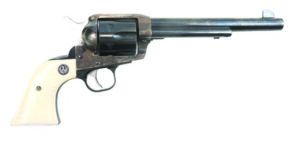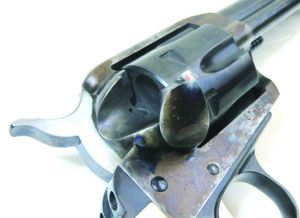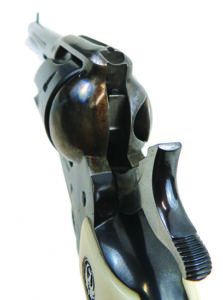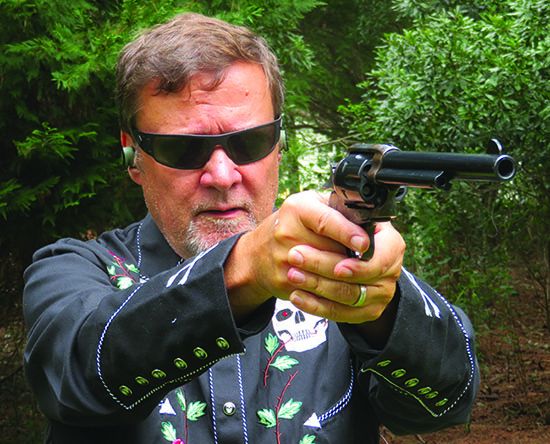In the June 2024 issue, we looked at two reproduction revolvers that allow you to experience what it was like to wield these guns in the Old West, except that the newer models sometimes have improved features and they certainly have improved materials. The first of those wheelguns were new sidearms chambered in 45 Colt, the Cimarron Firearms Co. Model No. 3, 1st Model American, and the Taylor’s & Company Cattleman Old Model Military Markings. We rated the Taylor’s Cattleman as a grade A gun, while the Cimarron earned a grade B nod.
This month, we’ll look at a used Ruger Vaquero in 45 Long Colt, the old model that is no longer produced, and a new Uberti 1872 Open Top Army CA910 in 44 Special. We evaluated these single-action revolvers for accuracy, sight regulation to point of impact, trigger weight, ease of use, and sight quality. These revolvers would do well in Cowboy Action Shooting matches or plinking on a weekend.
We first noticed these reproductions had great balance and manageable recoil, and they required some hammer dexterity to make a long stretch of the thumb to cock them. Sights ranged from too tiny to see well, to large and very modern.
We began accuracy testing using targets set at 15 yards and a range bag as a rest. We then fired the revolvers for speed using both one- and two-hand grips with the targets at 7 yards. Firing at speed shows how well the shooter can manage recoil and how fast you can acquire the sights for follow-up shots.
Naturally, we used some cowboy loads in lower velocities, which offer less recoil. They are also a good option for plinking. In 45 Colt, we fired Hornady Cowboy loads with 255-grain round-nose flat-point (RNFP) bullets and Choice Ammunition with a 250-grain RNFP bullet. Also, we used a more modern Federal American Eagle load with a 225-grain jacketed soft point (JSP). It’s worth noting that of the three 45 Colt revolvers, only the Ruger is compatible with +P ammo.
Once we had a chance to fill our hands with these pistols, here’s what we learned about these reproduction handguns.
Ruger Vaquero 45 Long Colt
$850
Gun Tests grade: B
There are reasons the Old Model Vaquero was replaced. It is heavy and does not have the balance of old-time single-action revolvers. It does have good accuracy, however, and can handle +P ammo.

| Action Type | Revolver, single action, hammer fired |
| Overall Length | 13.0 in. |
| Barrel Length | 7.5 in. |
| Barrel Twist Rate | 1:16 in. RH |
| Sight Radius | 8.5 in. |
| Overall Height | 5.0 in. |
| Maximum Width | 1.7 in. |
| Weight Unloaded | 47.2 oz. |
| Weight Loaded | 52.4 oz. |
| Cylinder Gap | 0.005 in. |
| Capacity | 6 |
| Frame Finish | Faux case hardened |
| Barrel/Cylinder Finish | Blued |
| Frame Front Strap Height | 2.3 in. |
| Frame Back Strap Height | 3.3 in. |
| Grip | Smooth faux ivory |
| Grip Thickness (maximum) | 1.4 in. |
| Grip Circumference (maximum) | 6.0 in. |
| Front Sight | Fixed blade |
| Rear Sight | U notch |
| Hammer Cocking Effort | 3.0 lbs. |
| Trigger Pull Weight | 3.5 lbs. |
| Trigger Span | 3.3 in. |
| Safety | Internal transfer bar |
| Warranty | None stated |
| Telephone | (336) 949-5200 |
| Website | Ruger.com |
| Made In | U.S. |
The Ruger Vaquero was introduced in 1993 in response to the popularity of Cowboy Action Shooting. The original, or Old Model Vaquero, is basically a New Model Blackhawk with fixed sights. The Old Model Vaquero was put out to pasture in 2005 when the New Model Vaquero was introduced, which has a smaller frame that is closer in size to a Colt-style Single Action Army (SAA). The old Vaqueros were rated for +P ammo; the new Vaqueros are not. This is partially why we wanted to look at an Old Model Vaquero and try to see if it was worth your while to try to locate one.
The lightly used sample we test here sported a 7.5-inch blued barrel and blued cylinder. The frame has a faux case-hardened finish. The real case-hardened finish is a heat treatment process that permeates into the metal. The Old Model Ruger Vaquero also sports faux ivory grips from Ruger. It’s a good looking gun, even stylish, except for all the legal jargon roll-marked along the left side of the barrel.

The mechanism incorporates a transfer bar, which is raised into firing position as the trigger is pulled. The hammer hits the transfer bar, which hits the firing pin housed in the frame. Traditional Colt-style SAA revolvers have the firing pin mounted in the hammer. Also different is the loading process and hammer positions. The Ruger has two clicks and two positions, fully forward and cocked. Colt-style SAA guns have four clicks and three hammer positions: fully forward, half cock, and full cock. The Ruger is loaded with the hammer fully forward. Swing out the loading gate and load all six chambers. The transfer bar allows the Ruger to be carried fully loaded. The old Vaquero does not have a reverse indexing pawl that allows the cylinder to be rotated clockwise and counter-clockwise with more leeway, so it is easier if you accidentally spin the cylinder past a chamber. The old Vaquero has a bit of wiggle room, but if the pawl clicks, you need to skip that chamber and move on to the next. Ruger made the loading process much simpler in the new model.
The trigger is wide and broke at a respectable 3.5 pounds. The sights are more modern than some of the other pistols, with a thicker front-sight post and a slightly wider notch in the top strap.
In hand, the Ruger is noticeably heavier than a Colt-style SAA, and the trigger span is longer. Field-stripping is fast and does not require tools. A feature of the old Vaquero is the base pin is trapped so it does not come out of the frame. This feature ensures you don’t lose the pin while in the field. On the new Vaquero, the base pin can be removed.

Shooting data showed the Old Model Ruger had the highest muzzle velocities of all the 45 Colt revolvers tested. The 0.005-inch cylinder gap helped amp up the Ruger’s muzzle velocity. The Vaquero shot dead on at 15 yards. Average accuracy across all ammo ranged from less than an inch to 3.2 inches for five-shot groups. Hornady Cowboy had the smallest group at 0.54 inches. The best Federal American Eagle group measured 1.77 inches, and the best Choice group was 2.24 inches. Recoil from the cowboy-velocity ammo in the big Ruger was like a gentle gelding. Loading up the +P Grizzly ammo, the Ruger became quite snuffy. The Grizzly launched a heavier bullet than the cowboy loads at twice the muzzle velocity. We’ll say the Grizzly load curled that Ruger in our grip mighty fast. The best group with the Grizzly measured 3.2 inches.
Going for speed, the Ruger plodded along due to its size. Now we know why the New Vaquero is smaller. The lighter Taylor’s shot circles around the big Ruger. There is no need to reset the trigger after each shot. Press the trigger and cock and release the hammer to shoot fast. Groups shot at speed measured 3 to 3.5 inches at 7 yards. Cases more often than not fell free from the chambers. We did need to use the ejector rod a few times and noticed the ejector head was tiny, so if you were not paying attention, you could singe the tip of your finger.
Our Team Said: The Ruger was heavier and absorbed recoil. The loading process is very simple, and we like the transfer-bar safety system. If we traveled in grizzly country, we wouldn’t think twice about taking this Ruger loaded up with +P ammo. But if you want speedy shooting, we’d pass on these old Vaqueros.
| 45 COLT RANGE DATA | |
| Hornady Cowboy 255-grain RNFP | Ruger Vaquero Old Model |
| Average Velocity | 801 fps |
| Muzzle Energy | 363 ft.-lbs. |
| Smallest Group | 0.54 in. |
| Average Group | 0.73 in. |
| Federal American Eagle 225-grain JSP | Ruger Vaquero Old Model |
| Average Velocity | 971 fps |
| Muzzle Energy | 471 ft.-lbs. |
| Smallest Group | 1.77 in. |
| Average Group | 1.86 in. |
| Choice Ammunition 250-grain RNFP | Ruger Vaquero Old Model |
| Average Velocity | 882 fps |
| Muzzle Energy | 432 ft.-lbs. |
| Smallest Group | 2.24 in. |
| Average Group | 2.77 in. |
| Grizzly 335-grain WLNGC +P | Ruger Vaquero Old Model |
| Average Velocity | 1427 fps |
| Muzzle Energy | 1515 ft.-lbs. |
| Smallest Group | 3.01 in. |
| Average Group | 3.23 in. |
To collect accuracy data, we fired five-shot groups from a bench using a rest. Distance: 15 yards with open sights. We recorded velocities using a ProChrono DLX digital chronograph set 10 feet from the muzzle.
Special thanks to Eastern Outfitters (EasternOutfitter.com) of Hampstead, NC, for their assistance.
Written and photographed by Robert Sadowski, using evaluations from Gun Tests Team members. GT


























